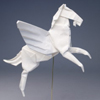geometry
Saul Schleimer and Henry Segerman show off some of their beautiful 3D printed mathematical structures.
Did you learn at school that the angles in a triangle always add up to 180 degrees? If yes then your teacher was wrong. Find out why here.
The Plus team's vehicle of choice is the bicycle, so we're particularly pleased about an announcement that hit the news this month: a clever car mirror that eliminates the dreaded blind spot has been given a patent in the US. The mirror was designed by the mathematician Andrew Hicks, of Drexel University, after years of puzzling over the problem.
Keats complained that a mathematical explanation of rainbows robs them of their magic, conquering "all mysteries by rule and line". But rainbow geometry is just as elegant as the rainbows themselves.
Rising like a giant pringle from the Olympic Park construction site, the Velodrome is the first of the 2012 London Olympic venues to be completed. With its sweeping curved roof and beautiful cedar clad exterior the Velodrome is a stunning building. But what most of the athletes are excited about is the elegant wooden cycle track enclosed inside, the medals that will be won, and the records that might be broken, in the summer of 2012.
The world we live in is strictly 3-dimensional: up/down, left/right, and forwards/backwards, these are the only ways to move. For years, scientists and science fiction writers have contemplated the possibilities of higher dimensional spaces. What would a 4- or 5-dimensional universe look like? Or might it even be true that we already inhabit such a space, that our 3-dimensional home is no more than a slice through a higher dimensional realm, just as a slice through a 3-dimensional cube produces a 2-dimensional square?
When your eyes see a picture they send an image to your brain, which your brain then has to make sense of. But sometimes your brain gets it wrong. The result is an optical illusion. Similarly in logic, statements or figures can lead to contradictory conclusions, which we call paradoxes. This article looks at examples of geometric optical illusions and paradoxes and gives explanations of what's really going on.
London, September, 1854. A cholera outbreak has decimated Soho, killing 10% of the population and wiping out entire families in days. Current medical theories assert that the disease is spread by "bad air" emanating from the stinking open sewers. But one physician, John Snow, has a different theory: that cholera is spread through contaminated water. And he is just about to use mathematics to prove that he is right.
